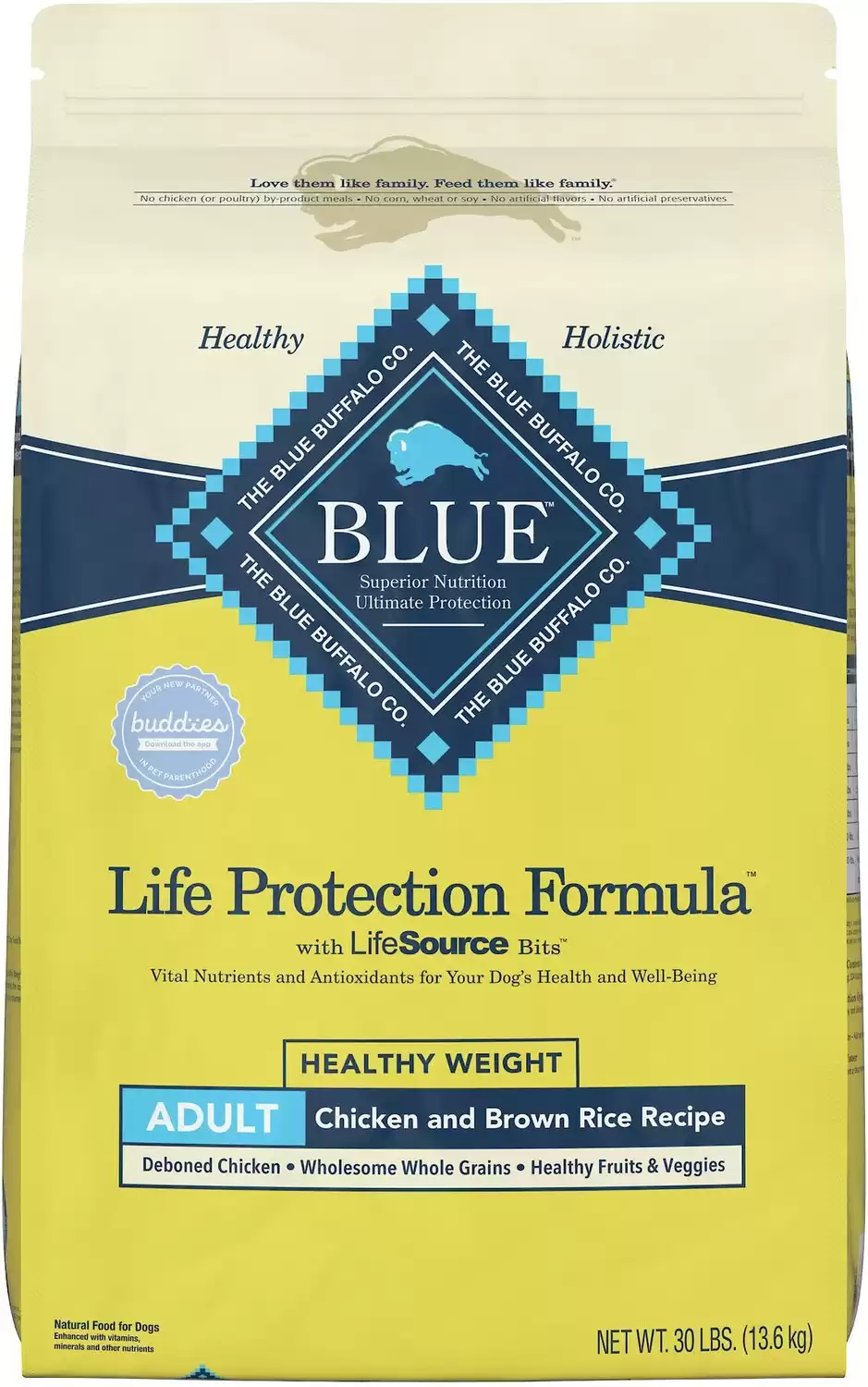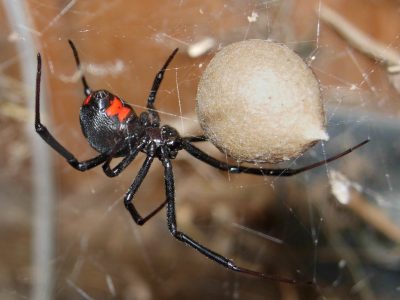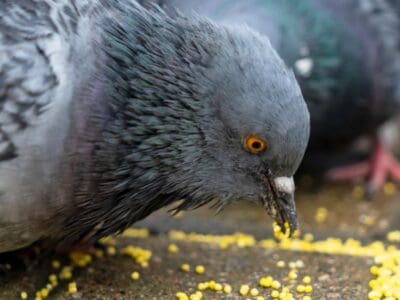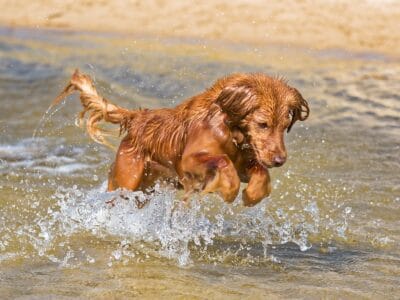American Eskimo Dog
Canis lupus
The American Eskimo was once a part of the Barnum and Bailey Circus with which it would tour the country and perform for astounded audiences.
Advertisement
American Eskimo Dog Scientific Classification
- Kingdom
- Animalia
- Phylum
- Chordata
- Class
- Mammalia
- Order
- Carnivora
- Family
- Canidae
- Genus
- Canis
- Scientific Name
- Canis lupus
Read our Complete Guide to Classification of Animals.
American Eskimo Dog Conservation Status
American Eskimo Dog Facts
- Fun Fact
- The American Eskimo was once a part of the Barnum and Bailey Circus with which it would tour the country and perform for astounded audiences.
- Distinctive Feature
- Bright, white coat and pointed ears
- Temperament
- Playful and smart
- Training
- Fairly easy
- Diet
- Omnivore
- Average Litter Size
- 5
- Common Name
- American Eskimo Dog
- Slogan
- The American Eskimo has splendid all white fur and an upturned tail
- Group
- Dog
American Eskimo Dog as a Pet:
- General Health
- Energy Level
- Shedability
- Trainability
- Intelligence
- Tendency to Chew
- Size
- Family and kid friendliness
- Yappiness / Barking
- High
- Separation Anxiety
- High
- Preferred Temperature
- Cold climate
- Exercise Needs
- High
- Friendly With Other Dogs
- High
- Pure bred cost to own
- $300 to adopt, more than $1,000 from a breeder
- Dog group
- Non-sporting
- Male weight
- 6-35 lbs
- Female weight
- 6-35 lbs
This post may contain affiliate links to our partners like Chewy, Amazon, and others. Purchasing through these helps us further the A-Z Animals mission to educate about the world's species.
View all of the American Eskimo Dog images!
The American Eskimo dog is a lively and alert dog breed with an all-white or biscuit fur color, striking black eyes, and a highly curved and upturned tail that bends back over the body.
Despite its name, this breed is not associated with the Inuit at all. Instead, it was bred from the German Spitz in the 19th century by immigrants who settled in the Midwest. Although originally developed as a farm dog, this breed became a popular performer at circuses and roadshows. After the United States entered World War I, the name was changed to the American Eskimo as a result of high anti-German sentiment running through the country. This breed is a great match for people who want a lovable, affable, and high-energy companion in their homes.
See all of our expert product reviews.
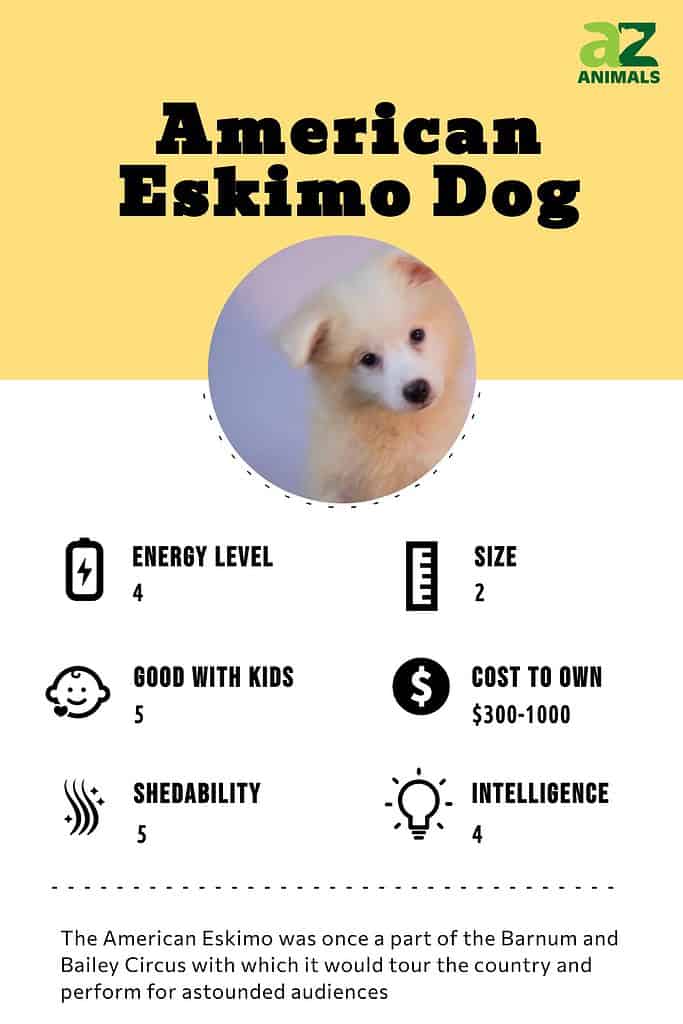
3 Pros and Cons of Owning an American Eskimo Dog
| Pros! | Cons! |
|---|---|
| Alert and Active The American Eskimo has an inquisitive mind and loves to explore its surroundings. | Destructive Behavior If this breed doesn’t receive enough attention or exercise, then it may seek out more destructive forms of activity. |
| Friendly and Social The American Eskimo loves to be around people and other dogs. | Barking The American Eskimo is very talkative, but not every owner may enjoy its tendency to bark, howl, or yap. |
| Healthy This breed has an excellent lifespan and relatively few health issues. | Separation Anxiety The flipside of its social personality is its high separation anxiety when left alone for long periods of time. |
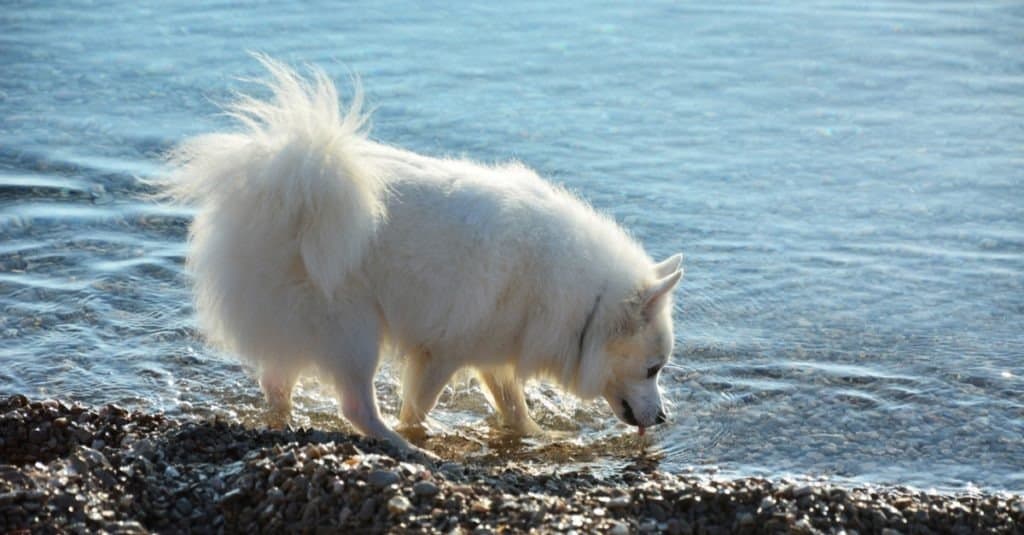
©T and Z/Shutterstock.com
History and Origins
The American Eskimo Dog’s name is a bit misleading as the Indigenous people that are referred to as Eskimos had no part in the breed’s origin. German immigrants who arrived in the United States in the early 1800s had a great influence on the development of the Midwest. Not only did they bring Lutheranism, the brewing industry, and German-style food, but they also brought along a Nordic breed of dog known as the German Spitz. These dogs quickly became popular show dogs due to their intelligence and agility, with Pierre, an Eskie tightrope walker, being one of the most famous performing dogs of the 1930s.
When the United States joined World War I in 1917, a prejudice against German things was widespread. Thus, the name of the breed was changed to the “American Eskimo Dog,” based on the name used by a spitz breeding kennel in Ohio. Although the breed has a long and interesting history in America, it was not until 1995 that the American Kennel Club first registered an American Eskimo Dog. These little white dogs did various tasks on farms in the Midwest and later entertained audiences at the circus. Nowadays, pet owners love them because they are adaptable, fun-loving companions.
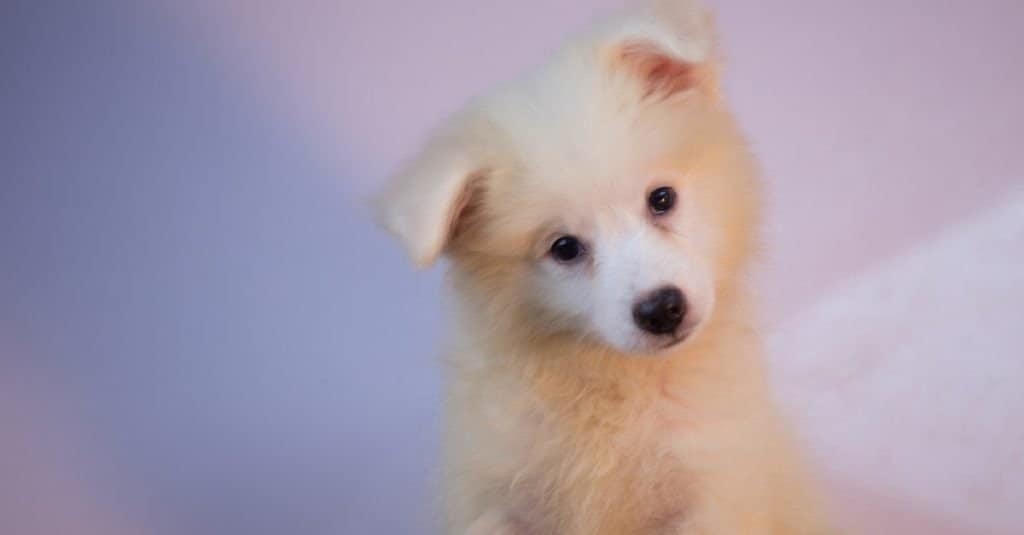
American Eskimo Dogs originated in Germany.
©Stockphoto5/Shutterstock.com
Health and Entertainment for your American Eskimo Dog
See all of our expert product reviews.
Reproduction and Puppies
The American Eskimo Dog typically has a gestation period of 63 days. Puppies are usually around 8 ounces at birth and will grow quickly in the first few weeks after they are born. The average litter size for an American Eskimo is between three to five puppies, though litter can range from one to eight puppies depending on the mother’s health and age.
American Eskimo Dogs are known for their intelligence and loyalty, making them an ideal pet. They come in three sizes: Standard, miniature, and toy. These fluffy white dogs have a unique trait that sets them apart from other breeds – biscuit-colored fur! According to the official breed standard, Eskies should have a mostly white coat with “biscuit” colored fur around the edges. This adds an extra layer of cuteness that we just can’t resist! With these traits in mind, it’s no wonder why American Eskimo Dogs are such popular pets.

American Eskimo Dogs are deaf and blind when they are born.
©T and Z/Shutterstock.com
Size and Weight
The American Eskimo comes in three different sizes: standard, mini, and toy. In the chart below, the high number represents the standard size, while the smaller figure represents the typical size of the toy dog. The mini is somewhere in between.
| Height (Male) | 9 to 19 inches |
| Height (Female) | 9 to 19 inches |
| Weight (Male) | 6 to 35 pounds |
| Weight (Female) | 6 to 35 pounds |
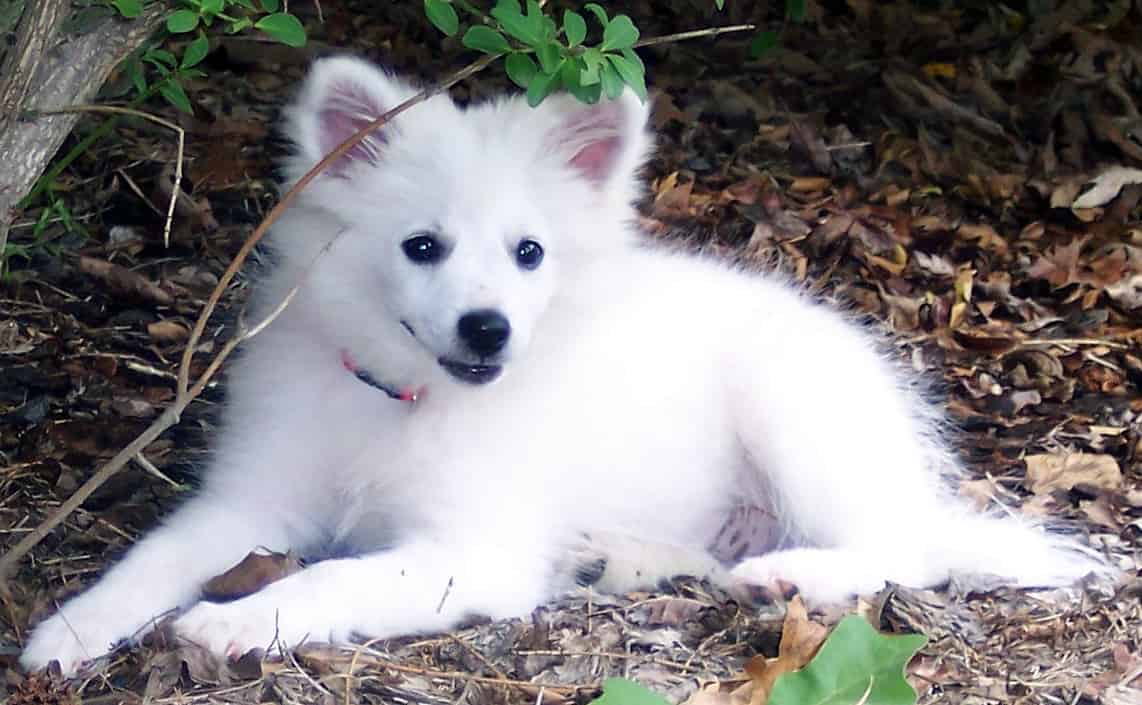
American Eskimo Dogs weigh between 6 and 35 pounds.
©en: User: StarSaber, CC BY-SA 3.0, via Wikimedia Commons – License
Lifespan and Health
The American Eskimo is a healthy breed with a life expectancy of around 13 to 15 years. Some of the rarer conditions you should still nevertheless look out for include hip dysplasia (in which the thighbone doesn’t fit perfectly into the hip joint), progressive retinal atrophy (the deterioration of the retina), cataracts (the clouding of the lens in the black eye), and Legg-Calve-Perthes Disease (in which the blood supply to the femur is partly cut off).
Regardless of the dog’s health history, you should always look out for early signs of cancer, skin diseases, and ear problems, which may develop at any time. To ensure the best health results, you should buy your dog from a reputable breeder and have annual health checks at the vet. To sum up the most common health issues:
- Cancer
- Eye Diseases
- Skin Conditions
- Hip Degeneration
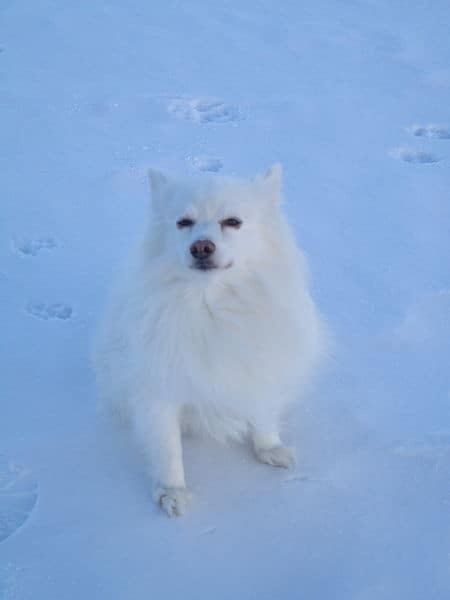
American Eskimo Dogs live for 13-15 years
©Billcanada, Public domain, via Wikimedia Commons – License
Temperament
The American Eskimo has a friendly personality that shines through in every way. Although not exactly a great hunting or working dog, its alert temperament and loud bark do make it well-suited as a watchdog. But more than anything, this breed is an excellent companion that loves to be around people who shower it with plenty of attention. The dog expresses its essential traits through barking, playtime, tricks, and its exuberant personality. It’s a little hesitant to make new friends, but this can be overcome with some effort.
Even though this highly active breed is always ready to exercise and play outdoors, the American Eskimo is very well-suited for an indoor environment. It is just content to have fun around the house and be with its owner. But it’s also important to set boundaries with this breed; take charge and give it plenty of guidance and activities to engage in. Otherwise, its roaming and energetic mind might find an outlet in rather destructive, annoying, or neurotic behavior.
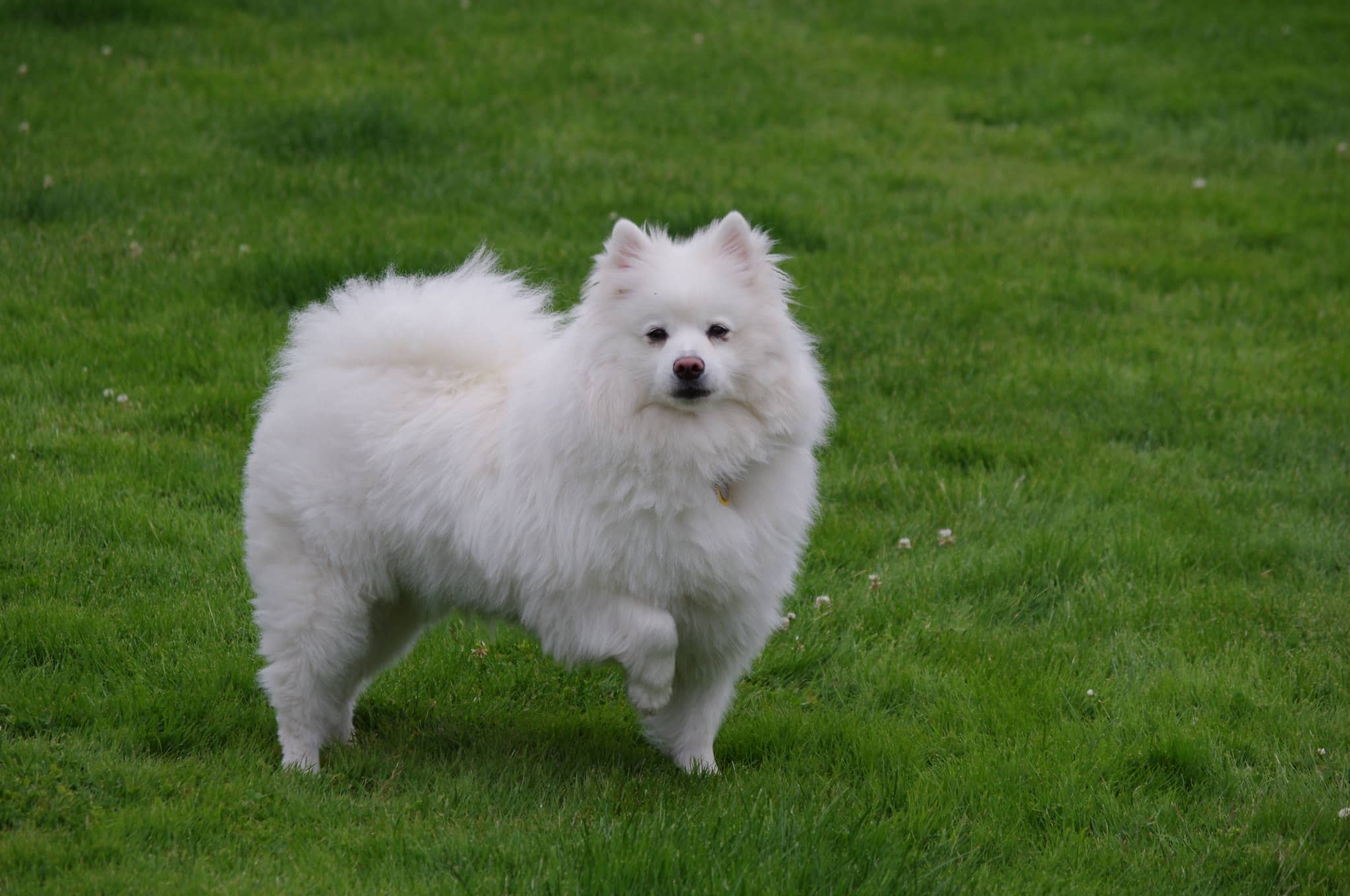
American Eskimo Dogs need plenty of daily exercise. They are an active breed.
©Chris[tmas] K / CC BY-SA 2.0, Flickr – License
Care
The American Eskimo is a high-maintenance dog that requires a lot of care and attention to satisfy its needs. If you’re not prepared to sacrifice time and expense on exercise, grooming, training, and nutrition, then this might not be the right dog breed for you. For best results, you should make sure the dog is fully trained as a puppy.
The Best Dog Food
The American Eskimo should be fed on half a cup to 1.5 cups of high-quality dry food divided in two separate meals (though the exact amount depends on the dog’s age, size, activity level, and metabolism). Dog treats are also a useful way to reinforce training. Obesity isn’t a significant problem for this highly energetic breed (at least until middle age), but you should nevertheless keep an eye on its weight and be prepared to adjust its calorie intake as needed.
Since American Eskimo dogs are rather healthy, there are many dog foods that will do them good. A food that helps with shedding might even be an option if your American Eskimo’s shedding is hard to manage. A-Z Animals is glad to advise American Eskimo dog owners to try Blue Buffalo Life Protection Formula Natural Adult Dry Dog Food.
For American Eskimo’s hips to support them throughout their life, this food provides ample glucosamine and calcium. There’s also taurine and Vitamin A for healthy eyes.
Check Chewy or Amazon for this product.
- Formulated for dogs that are less active and/or simply have trouble maintaining a healthy weight
- The first two ingredients are chicken and chicken meal
- Whole grains, including brown rice and barley, provide extra fiber so your dog will feel full longer
- Added calcium and phosphorus improve your dog's overall health, especially as they age
- All minerals are chelated for easier absorption
Maintenance and Grooming
The American Eskimo has a thick, elegant double coat of fur, but with a tendency for shedding, it requires two or three brushing sessions per week to remove dead hairs and prevent matting. Because of the natural oils produced by its fur, this breed doesn’t require too much cleaning. It is okay to bathe the dog after a particularly dirty outside adventure, but doing so more than once every few months could cause dryness and irritation. In addition to all of this, the nails should be trimmed, and the ears cleaned out regularly to prevent health problems.
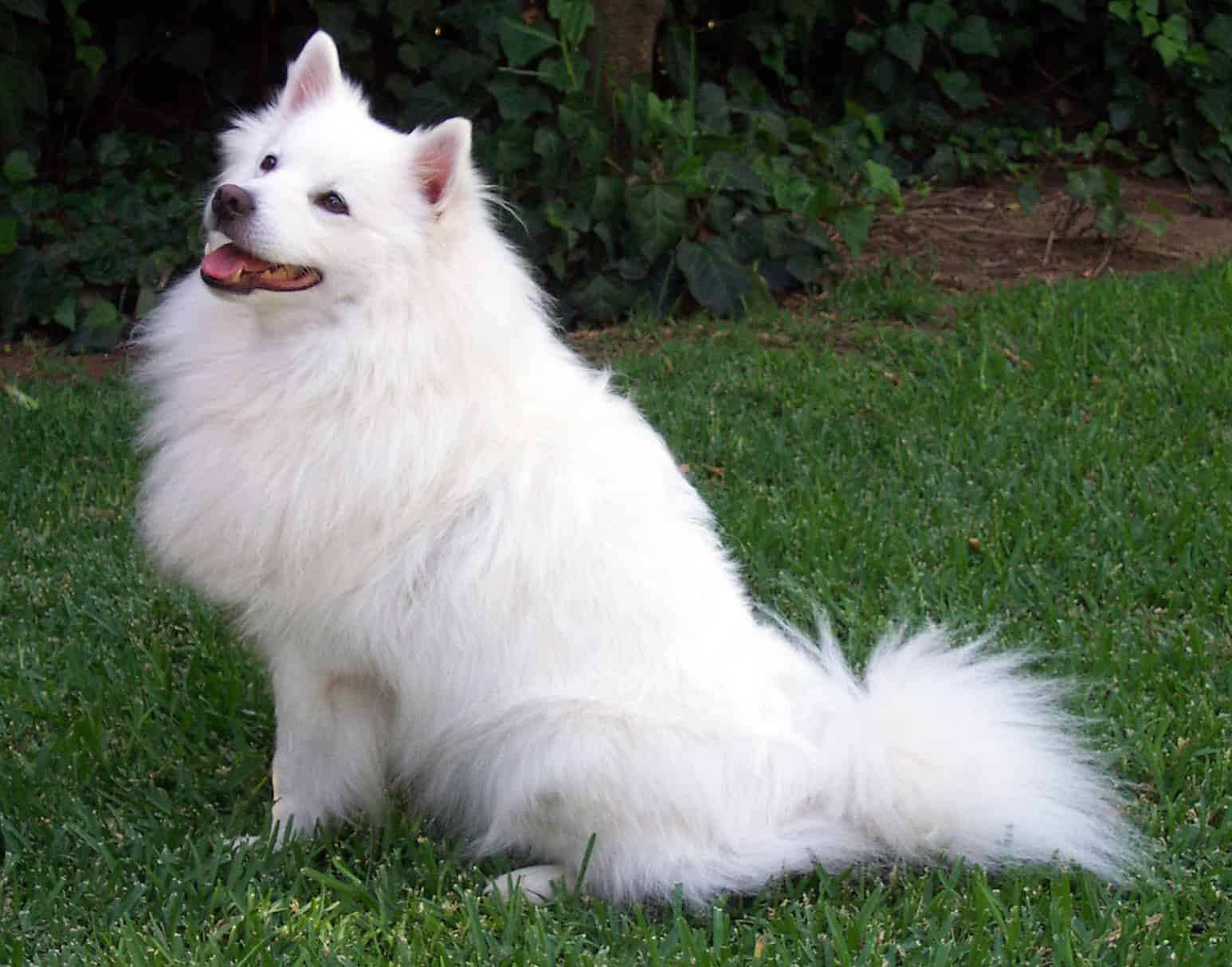
American Eskimo Dogs are high-maintenance breeds.
©Isfand92/Shutterstock.com
Training
The American Eskimo is one of the most eager and outgoing breeds you can find. As a regular performance dog, this breed will easily follow directions and quickly learn commands, sometimes just by watching and mimicking others. Early obedience training is a must for this breed. Otherwise, for all of its friendliness, the dog’s strong, independent personality may assert itself and exhibit some bad behavior. It’s not impossible to reverse this bad tendency as an adult, but you will need to put in some extra work.
Exercise
The American Eskimo is a high-energy breed that requires a large amount of mental and physical stimulation throughout the day. It is a good idea to give it a fenced yard in which to play and plenty of toys to divert its attention. It also enjoys long walks or runs outdoors and does well in both snowy environments and water, but in hot weather, you should make sure it is properly hydrated and has enough shade. Only after entering middle age will the American Eskimo slow down and become a lot more docile.
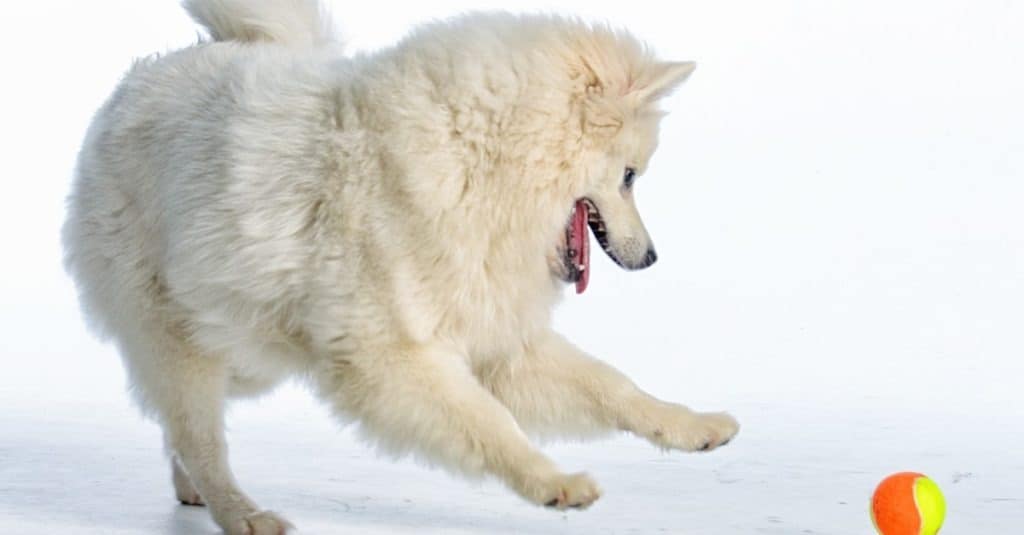
The American Eskimo is a high-energy breed that requires a large amount of mental and physical stimulation throughout the day.
©iStock.com/cherry williams
American Eskimo Puppies
Puppyhood is a very important time for the American Eskimo. It needs to be properly acclimated from an early age to obey human commands. If it is not properly trained and socialized as an adolescent, then this breed may experience significant behavioral problems later on in life, much more than the typical dog breed. Your puppy should also be subject to an early health screening from the vet to check for potential problems and administer all of the necessary shots.

©Stockphoto5/Shutterstock.com
American Eskimo Dogs and Children
With its friendly nature and playful personality, the American Eskimo loves to be around children. The standard American Eskimo is just the right size to interact with children. It isn’t large enough to intimidate them but isn’t small enough to be overly delicate. The only real problem is that the breed’s high energy and activity level might be startling to smaller children. That is why you should always supervise every interaction between your dog and your children and never leave them alone together.
Dogs Similar to the American Eskimo
If you enjoy the American Eskimo, then you might want to check out these similar breeds.
- German Spitz – The German Spitz is the original breed from which the American Eskimo descended. Coming in five different varieties (the Wolfspitz, Giant Spitz, Medium Spitz, Mini Spitz, and the Pomeranian), this breed has a long double coat of fur with some variation of white, black, cream, brown, or red/orange coloration.
- Samoyed – Originating from the frigid lands of Siberia, the Samoyed has a very similar appearance to the American Eskimo, with the white/biscuit fur and the curved tail. This all-around intelligent and hard-working breed was originally used for hauling sleds and protecting its owner.
- Finnish Spitz – Another member of the Spitz family, the Finnish Spitz also has a similar appearance as the American Eskimo but with a kind of brown-orange coat color. This alert and active breed was originally used as a type of bark pointer, which identified hunting game by barking loudly.
American Eskimo vs. Samoyed
Both breeds are very similar, but the main difference is that the Samoyed is a larger working breed with a thick wool undercoat and a harsher outer coat. Most Samoyeds are no smaller than 19 inches, whereas the American Eskimo is 19 inches at most.
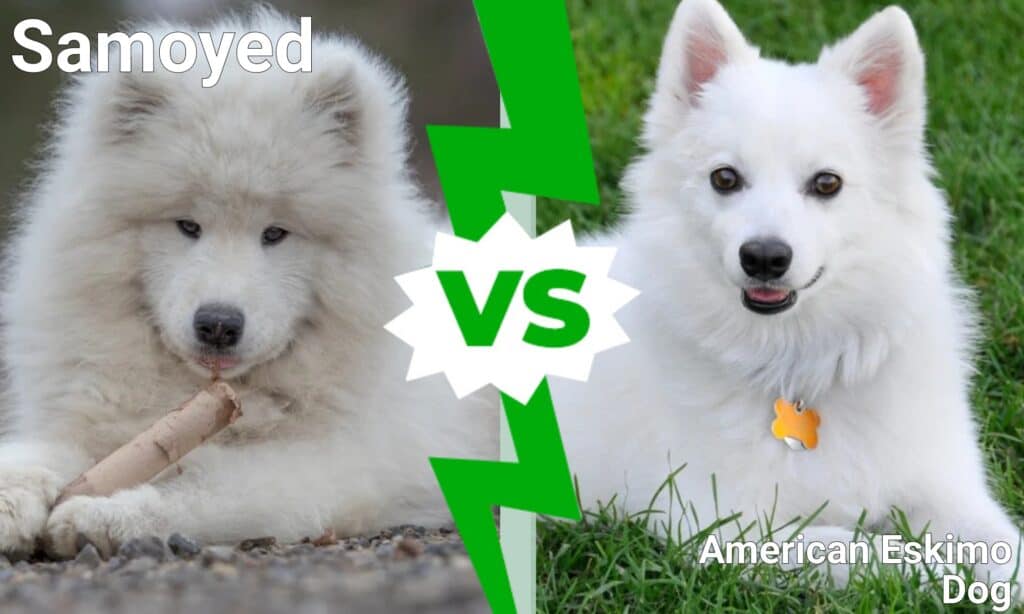
Famous American Eskimo Dogs
The American Eskimo ranks about in the middle in terms of popularity, having only been recognized by the American Kennel Club in 1995. However, it was a more common sight in road shows during the 19th and early 20th centuries. An American Eskimo by the name of Stout’s Pal Pierre was a tightrope walker for the Barnum and Bailey Circus.
Popular Names
Besides a few very apt names like Ghost, most American Eskimo names will be the same as any other dog breed. According to Rover.com, these are the most popular general dog names:
- Max
- Bella
- Charlie
- Luna
- Cooper
- Lucy
- Buddy
- Daisy
- Milo
- Lola
American Eskimo Dog FAQs (Frequently Asked Questions)
Are American Eskimo Dogs herbivores, carnivores, or omnivores?
American Eskimo Dogs are Omnivores, meaning they eat both plants and other animals.
What Kingdom do American Eskimo Dogs belong to?
American Eskimo Dogs belong to the Kingdom Animalia.
What class do American Eskimo Dogs belong to?
American Eskimo Dogs belong to the class Mammalia.
What phylum to American Eskimo Dogs belong to?
American Eskimo Dogs belong to the phylum Chordata.
What family do American Eskimo Dogs belong to?
American Eskimo Dogs belong to the family Canidae.
What order do American Eskimo Dogs belong to?
American Eskimo Dogs belong to the order Carnivora.
What type of covering do American Eskimo Dogs have?
American Eskimo Dogs are covered in Hair.
What genus do American Eskimo Dogs belong to?
American Eskimo Dogs belong to the genus Canis.
What are some distinguishing features of American Eskimo Dogs?
American Eskimo Dogs have bright, white coats and pointed ears.
How many babies do American Eskimo Dogs have?
The average number of babies an American Eskimo Dog has is 5.
What is an interesting fact about American Eskimo Dogs?
American Eskimo Dogs are bred to be companion dogs!
What is an American Eskimo dog?
The American Eskimo is a small or medium-sized dog with long, thick, white fur, short, upturned ears, a curved tail, and an alert personality. As a member of the Spitz family, this breed is well-adapted for harsher northern climates. Spitz dogs also retain some small wolf-life characteristics.
What is the price of an American Eskimo dog?
The price of adopting an American Eskimo is usually at least $300. If you plan to purchase a newly born puppy from a reputable breeder, however, then the price may be somewhere between $1,000 and $3,000.
Are American Eskimo dogs good pets?
The American Eskimo gets along well with adults, children, and some pets with whom it has become familiar. But it does have a tendency to chase smaller mammals and birds.
Are American Eskimo dogs dangerous?
The American Eskimo’s reservation around strangers generally does not translate into aggression. This is an affectionate breed that wants to get along with people.
Do American Eskimo dogs shed a lot?
Yes, the American Eskimo is a shedding breed that requires fairly frequent brushes. But because of the natural oils produced by the fur, it is relatively easy to keep this breed clean.
What is the scientific name for the American Eskimo Dog?
The scientific name for the American Eskimo Dog is Canis lupus.
What is the lifespan of an American Eskimo Dog?
American Eskimo Dogs can live for 13 to 15 years.
Thank you for reading! Have some feedback for us? Contact the AZ Animals editorial team.
Sources
- American Kennel Club, Available here: https://www.akc.org/dog-breeds/american-eskimo-dog/
- Dog Breed Info, Available here: https://www.dogbreedinfo.com/americaneskimo.htm






